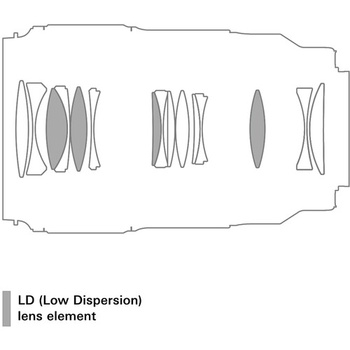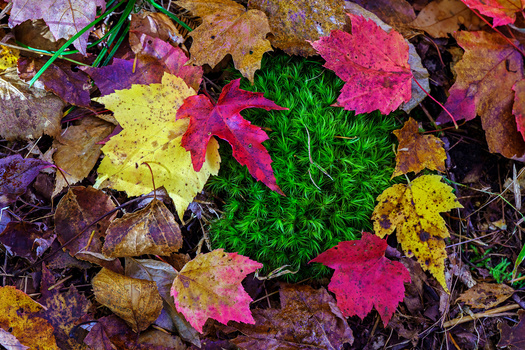If you're in the market for a new macro lens for your Sony E or Nikon Z mount, you're definitely going to want to check out the new Tamron 90mm f/2.8 Di III VXD. I recently had the pleasure of testing this lens to review for you all, and I have to say, in price, quality, and features, it is spot on. Let's dive into it, and I'll share why.
Right off the bat, this macro lens is packed with features and thoughtfully engineered for beautiful macro imagery on full frame mirrorless camera bodies. The first point I want to draw attention to about this lens is that it has a 12-blade circular aperture design. This means it creates a perfectly circular bokeh wide open. So if you love having a tack-sharp subject and a perfectly creamy background, you're going to love this lens. You can also stop down to use it to create 12-point starbursts instead. You'll see in my example photos, as I'm someone who loves a shallow depth of field, that I was enjoying using this lens so much. I'm so sad to have to send it back to Tamron.
In using the Tamron 90mm f/2.8 Di III VXD for about a month on all different kinds of subjects, I noticed that it was extremely fast to autofocus. This is due to the high-speed and high-precision VXD elements, which improve both locking onto a subject and tracking performance. One trick I like to use when photographing macro subjects is continuous autofocus mode, even if I'm on a tripod. That way, if the flower or insect I'm photographing moves slightly, my focus will still stay locked onto the target. Between my camera's continuous AF and the high-precision VXD, my focus remains tack sharp and locked onto exactly what I want.
Customization Features
The next point about focusing that I have to mention is the focus-limiting switch. This switch allows you to reduce your autofocus range and prevent it from searching or hunting. This is such a common trouble spot when photographing tiny macro subjects on a busy background. Solving that problem is a big help! Tamron took it a step further—not only does this lens have a focus-limiting switch, it even has three settings. Most only have two! First, you have full range if you don’t want to limit anything. Then there's an Infinity to 0.7m setting for distant subjects. Lastly, there’s a 0.7m to MOD setting for subjects up close to the minimum focusing distance. I found myself using this last setting most often. When up close to those tiny details, I wanted my equipment to know what I was doing so I didn’t have any frustration from it trying to focus elsewhere. Most lenses only have two settings, so with three, you really have customization just the way you like it.

Speaking of customization, the Tamron 90mm f/2.8 Di III VXD is also compatible with the Tamron Lens Utility Software. This allows you to customize settings, assign functions, and update the firmware when new releases come out. Because the lens has an assignable focus set button, you can use Tamron Lens Utility Software to reconfigure the button and set your lens up just how you like it.

In addition to the assignable focus button and focus-limiter switch, this lens also has one more little improvement that I really enjoyed. It’s a small but thoughtful detail—the lens hood has a specially designed sliding window. This window means you can rotate a circular polarizing filter or swap out your filter without having to disassemble everything. Because I often photograph in both vertical and horizontal compositions, and as you know, using a circular polarizing filter means adjusting its rotation as you turn the camera. With the Tamron 90mm f/2.8 Di III VXD, the little window slides right open, allowing me to rotate the filter and orient it properly. Or, if I decide I don’t want the filter or want to adjust its strength, there’s that window again. This matters when you're already very, very close to the subject doing macro, and you don't want to disturb whatever you're photographing. It’s so easy, and I got so used to it that I didn’t even have to take my eye away from the viewfinder to rotate my polarizing filter through that window.

Main Stats
For photographers who like a small form factor, this lens is compact, at just 5 in. in length and weighing only 1.4 lb. It uses a 67 mm filter size. As is common in modern macro lenses, its maximum aperture wide open is f/2.8. Its minimum focus distance is 9.1 in. All of these specifications mean that whether you're using the lens’s autofocus to shoot handheld or on a tripod, you can get up super close to the subject, as we like for macro.
Additional features in this lens, commonly found in modern Tamron lenses, include protective elements. You’ve probably heard me mention these often. I never want to let weather, heat, humidity, cold, or anything else get in the way of photographing. So I’m always happy to see when a lens like this Tamron 90mm f/2.8 Di III VXD macro has moisture-resistant construction and fluorine coating.
Nerd Time
The BBAR-G2 coating is a specific feature of this lens. Not to nerd out on you too much, but that’s Tamron’s latest Broad-Band Anti-Reflection Generation 2 coating. It’s a technology that reduces ghosting and flare. It’s made up of multiple layers of both low- and high-index materials deposited onto the lens surface using Electron Beam Deposition. Whether or not all of these technical details are your thing, what matters most is what this technology means in use. With the BBAR-G2 coating, you’ll get fine subject detail with true clarity and increased contrast, regardless of lighting conditions. Paired with the fluorine coating, which is water- and oil-repellent, you’re well equipped.
Long story short, if you're out photographing in a little light rain, you don’t have to worry. Humidity, no problem. Snow, no big deal. I know for myself, when there's a bit of weather—snow or dew in the morning—that’s my favorite time to photograph! Golden sunrise light with foliage and flowers will have little water droplets in warm seasons or frost on them in cold. Even if you get a cloudy sky overhead, that is just nature’s giant softbox, creating the gentlest, most even lighting. Knowing that my gear is protected with moisture-resistant construction and coatings, I can keep photographing without worry. However, if the weather suddenly turns for the worse and there’s a downpour, I always keep a rain cover in my camera bag just in case.
Field Test
So we've discussed the specs and features of this lens, but let's talk about how it performed in the field. The timing of me receiving this lens for review couldn’t have been better. I got it at the very end of September, which for me in the northern hemisphere meant a whole month of playing with it during autumn colors. I took it on all of my autumn road trips and hiking adventures, photographing everything from leaves, to late-blooming flowers, insects, fungi, and all the little woodland textures and colors you can find. Testing it in a variety of locations and subjects, on different days and in different light, really gives you an idea of how this lens will stand up to real use in your kit.
You’ll hear me say it often, but I really did enjoy the Tamron 90mm f/2.8 Di III VXD macro lens. The focus limiter and how fast and sharp it was—it just kept me taking macro pictures. I’d get lost for hours exploring tiny details on the forest floor. The focus limiter helped ensure that I only focused on what I wanted. So I would approach photography in little sessions. Sometimes, switching your mindset from big panoramics to macro can be difficult. For me, I’d set the focus limiter at 0.7m to minimum and start with only the tiniest, closest textures. Then, I might wander farther to find larger subjects. That’s when I’d switch the focus limiter to the opposite range, from 0.7m to infinity, and start thinking in that size and range. This feature helped me compartmentalize and make more sense of the chaotic forest floor, with all its hues and layers. Feel free to click on the gallery images in this review to see the fine macro details and colors up close.
Forest Flat Lay Series
If you’ve seen other reviews or follow me online, you know I love creating flat lays using organic materials from the forest. If you’re unfamiliar, flat lays are images taken directly above, like a bird’s-eye view, of carefully arranged objects. It’s often used in high-end product or commercial photography. Instead, I like to use it with leaves and sticks. I’m quirky like that. This lens was perfect for flat lays, and I included some pictures above of the flat lays I created and photographed with it. As someone who paints, draws, and sculpts in addition to photographing, flat lays activate the artistic part of me, where I’m creating by hand and curating in addition to photographing. The fast, sharp Tamron 90mm f/2.8 Di III VXD macro lens with its 3-mode focus limiter switch was the perfect tool for achieving these artistic visions.
Want One? Me too
All in all, this is a fine showing from Tamron in its newest generation macro lens. It has an array of features suited for macro photography combined with high-quality optics at a price point many will find accessible. As I mentioned earlier, I am sad to send this lens back—I was having so much fun photographing with it. The Tamron 90mm f/2.8 Di III VXD macro lens just released for purchase on October 24th at $699 in mounts for both Sony E and Nikon Z full-frame mirrorless. If you would like to add the Tamron macro to your kit before me, you can find it here on B&H.com.



































What is the ratio of that lens ?
1:1
This is a genuine question. I am not trying to take sides or pick a fight. The Sony E mount throat is 46.1 mm and the Z mount is 55mm. Is the Z mount version compromised in any way by the lens also having to suit a much smaller throat?
What you have asked is a bit of a can of worms and a pretty complex subject. You could say the compromise on throat size is all Sony’s with the E mount being originally designed for ASPC. Look at the front of a Sony full frame camera and the sensor just fits and no more… it’s pretty tight. Compare that to the front end of a Nikon Z mount that has much more room! The Z mount with its bigger throat size that can in theory take any lens could be argued to be ‘theoretically’ better! However in the real world I would imagine in regard to the Tamron 90mm it makes no difference in how the lens performs. Again in theory, bigger throat sizes allow for bigger and faster lenses that let in more light….
Hi Robert. You raise an interesting question. The size difference in mount between Sony E 46.1mm and Nikon Z 55mm is how the camera body is engineered. Therefore, that difference exists regardless of any lens attached to the body. Now onto the practical part of your question: does the size difference affect the amount of light let in? It's complicated.
There is some debate on online forums that you are getting a pinch more light and therefore more low light performance with the Z mount because the mount size is larger.
You probably already know this but other readers may not. The aperture of your camera is how to tell the lens how much light to let into the camera. The aperture is like a window (or diaphragm) that opens and closes to different sizes. It is in the lens, not the camera. While apertures have standard f stops such as f/4, an aperture opening of f/4 is not the same physical size on all lenses. These f stops are actually fractions. If you have a 100mm lens set to f/4, then the size of the opening is 1/4th of 100mm or 25mm. Therefore, aside from other important settings like shutter speed, the focal length and the aperture (diameter of the diaphragm) affect how much light are let onto the sensor. The sensor that receives this light is crucial to deciding the cameras light performance.
If you have a 90mm lens set at f4 on your camera then the physical opening of the aperture is 22.5mm. This is the "size" of how much light is let in, not your mount size.
However look up the low light and metrics and ratings for specific cameras that you are interested in via a stats comparison site. You have to look at the whole picture rather than just the mount and pick the camera and system that is best suited to your needs.
Example: https://cameradecision.com/compare/Nikon-Z8-vs-Sony-Alpha-A7R-V
The question some people would like to know the answer to is how does it compare to the Sony 90mm f2.8 long regarded as a pretty sharp lens that’s been around for a long time. Checkout the numbers on dxo. For most macro photographers who shoot subjects such as insects shooting wide open does not come into the mix. In that scenario it’s all about dof and sharpness. I’ve used the Sony 90mm for seven years and found it to be a great lens. Most who own the Sony 90mm are not going to swap it for this Tamron. New macro shooter however most likely want to know which lens gives the best bang for buck. Its spec is very similar to the Sony both being 1:1 and like the Tamron the Sony also has the three step focus limiter, but the Tamron comes in around £200 cheaper. For many that would be the clincher if it delivers similar results. A review that provided such a comparison would for many be really helpful. I have to say the lay flat images for me are not quite the subjects that really showcase a macro lens. I think a better choice of subjects would have helped. The most important omission however is how this lens works with focus bracketing found on Sony cameras such as the A7R5 which is valuable especially for product photographers. I would imagine the Tamron would work with this feature but it would have been helpful if this important macro feature was covered.
I appreciate your feedback. Unfortunately I do not own an a7R5 or the Sony 90mm to be able to help you with the comparisons that you would prefer. I could only test the lens that I was sent to try out with my own gear. As far as the subjects, I photographed as I would with a macro. With it being fall color time, that is what I was photographing. Whenever I receive any gear to try I just use it as I normally would and give my honest opinions. There may be other reviews around that are offering more bracketing style or the specific subjects you'd prefer, and may offer the comparisons you request. I think that in my review I am offering a free, not sponsored, honest look at how it performed for me and example photos from my real world testing.
I wholeheartedly agree with you, Eric; a more comprehensive review of a specialty lens is definitely in order. I, too, own the Sony 90 mm, and the value proposition of the aforementioned content in the article was suspect at best. You've made solid points, and I would like to see Fstoppers articles on specialty gear embrace a deeper dive and address the myriad of options available for the said product.
Hi Colin! I'm sorry that you feel my article is "suspect at best." Unfortunately as I mentioned earlier to Eric, when we are sent gear by a manufacturer to try out it is on loan. With these kinds of reviews, there is no budget or sponsorship for me to acquire other gear to test with. We are only able to test it with and versus gear that we already own personally. This means you can rest assured you are getting my honest opinion on how it performed. It also means though that it is not possible for me to test it with the "deeper dive and address the myriad of options" via comparisons of all other gear options as you would prefer. This review is my opinion as a full time working professional, I enjoyed the lens and used it as I do in my own work. I think calling my work suspect is unfair but on the internet people say whatever they please. There are other technical sites that offer testing and comparisons and therefore might be better suited to what you are looking for.